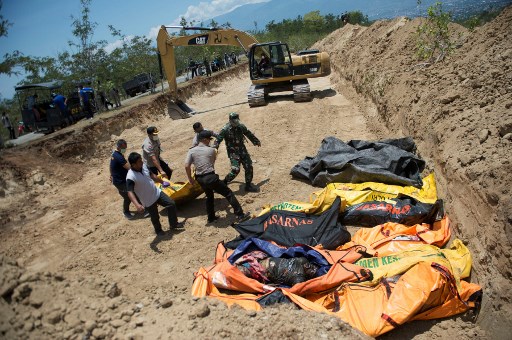

Mass graves were being readied on October 1 for hundreds of victims of the Indonesian quake and tsunami as authorities battled to stave off disease and reach desperate people still trapped under shattered buildings. / AFP PHOTO / BAY ISMOYO
by Harry Pearl
Agence France Presse
PALU, Indonesia (AFP) — Indonesian volunteers began burying bodies in a mass grave with space for more than a thousand people on Monday, victims of a quake-tsunami that devastated swathes of Sulawesi and left authorities struggling to deal with the sheer scale of the disaster.
Indonesia is no stranger to natural calamities and Jakarta had been keen to show it could deal with a catastrophe that has killed at least 844 people, according to the latest official count, and displaced some 48,000 more.
But four days on some remote areas are only now being contacted, medicines are running out and rescuers are struggling with a shortage of heavy equipment as they try to reach desperate victims calling out from the ruins of collapsed buildings.
In response, President Joko Widodo opened the door to the dozens of international aid agencies and NGOs who are lined up to provide life-saving assistance.
“Last night, President @jokowi authorized us to accept international help for urgent disaster-response & relief,” senior government official Tom Lembong wrote on Twitter on Monday.
Officials fear the toll will rise steeply in the coming days and are preparing for the worst, declaring a 14-day state of emergency.
At Poboya — in the hills above the devastated seaside city of Palu — volunteers began to fill a vast grave with the dead, with instructions to prepare for 1,300 victims to be laid to rest.
Authorities are desperate to stave off any disease outbreak caused by decomposing bodies, some now are riddled with maggots.
Three trucks arrived stacked with corpses wrapped in orange, yellow and black bags, an AFP reporter on the scene saw. One-by-one they were dragged into the grave as excavators poured soil on top.
– Twisted wasteland –
In Balaroa, a Palu suburb once home to a housing complex, the scale of the damage was obvious. A wasteland of flattened trees, shards of concrete, twisted metal roofing, door frames and mangled furniture stretched out into the distance.
Dazed groups of people ambled over the wreckage, unclear where or how to start digging. Among them were three men looking for their younger brother.
Rescuers are racing against the clock and a lack of equipment to save those still trapped in the rubble, with up to 60 people feared to be underneath one Palu hotel alone.
Two survivors have been plucked from the 80-room Hotel Roa-Roa, Indonesia’s search and rescue agency said, and there could still be more alive.
Desperate survivors turned to looting shops for basics like food, water and fuel as police looked on, unwilling or unable to intervene.
“There has been no aid, we need to eat. We don’t have any other choice, we must get food,” one man in Palu told AFP as he filled a basket with goods from a nearby store.
Meanwhile government officials said some 1,200 inmates fled at least three prisons in the region.
“I’m sure they escaped because they feared they would be affected by the earthquake. This is for sure a matter of life and death for the prisoners,” Ministry of Justice official Sri Puguh Utami said.
Many survivors have spent the last days desperately searching for loved ones while dealing with the trauma of the disaster.
One survivor, Adi, was hugging his wife by the beach when the tsunami struck on Friday. He has no idea where she is now, or whether she is alive.
“When the wave came, I lost her,” he said. “I was carried about 50 metres. I couldn’t hold anything,” he said.
Others have centred their search for loved ones around open-air morgues, where the dead lay in the baking sun — waiting to be claimed, waiting to be named.
In other places, the picture was even less clear.
Indonesia’s Metro TV broadcast aerial footage from the southern suburb of Petobo, where the devastation appeared extensive.
According to government estimates there could be up to 700 people killed there alone, with many of the 1,747 homes destroyed.
“We don’t know how many casualties there are at the complex” said Sutopo Purwo Nugroho, the national disaster agency spokesman.
– Ports, bridges, roads shattered –
Yenni Suryani, of Catholic Relief Services, said devastated infrastructure was hampering rescue efforts.
“Humanitarian groups are struggling to get people into affected areas,” she said. The main airport at Palu was damaged, landslides had cut off key roads while “power is out almost everywhere,” she added.
The local airport has been cleared to receive humanitarian and commercial flights, but so far the landing slots have been taken up by Indonesia’s powerful military, which is staging its own assistance efforts.
Satellite imagery provided by regional relief teams showed severe damage at some of the area’s major ports, with large ships tossed on land, quays and bridges trashed and shipping containers thrown around.
A double-arched yellow bridge had collapsed, its ribs twisted as cars bobbed in the water below.
Indonesia, home to 260 million people, is one of the world’s most disaster-prone nations.
It lies on the Pacific “Ring of Fire”, where tectonic plates collide and many of the world’s volcanic eruptions and earthquakes occur.
A massive 2004 quake triggered a tsunami that killed 220,000 throughout the region, including 168,000 in Indonesia.
© Agence France-Presse
